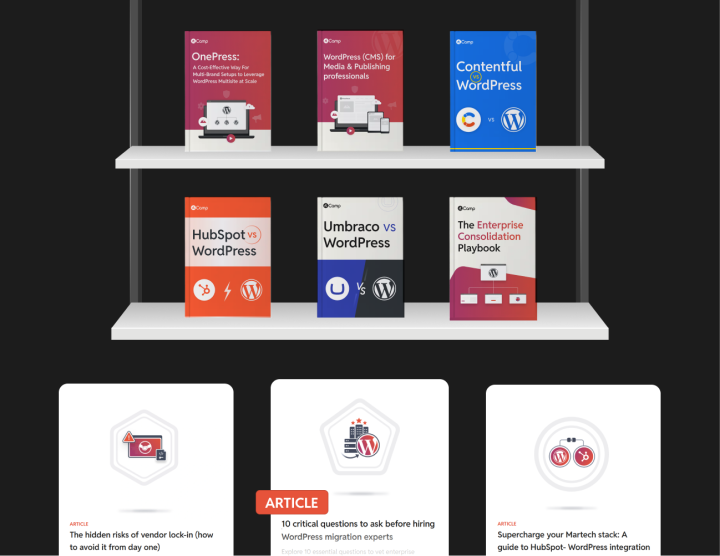Implementing enterprise-ready digital asset management (DAM) in WordPress
When considering an enterprise DXP, seamless media content delivery is crucial, as images and videos play a key role in the overall content strategy. That’s why DXPs often incorporate a dedicated digital asset management (DAM) solution—like AEM does.
In a composable DXP setup, on the other hand, enterprises typically use at least a vendor’s DAM alongside their CMS. In fact, that’s the most basic form of a DXP—for instance, the Sitecore CMS paired with Sitecore DAM.
Let’s now explore what enterprises really need from a DAM solution—and how WordPress can serve as a powerful DAM platform, both through its built-in Media Library and its integrations with enterprise-level DAM systems.
| 📌 On a side note: At rtCamp, we’ve migrated several AEM enterprise websites to WordPress, and we’ve often found that with Media Library customizations and scalable infrastructures, an external DAM service isn’t always necessary—definitely not for all enterprises. Also, bringing digital asset management natively to WordPress doesn’t just simplify asset management but also leads to significant cost savings, eliminating the need to pay for DAM features you don’t need or use. (And this isn’t exclusive to just AEM to WordPress migrations involving a DAM solution.) |
Organizing images, videos, and documents for easy access
Effective digital asset management begins with an organized approach to storing and categorizing your assets. WordPress offers a flexible Media Library that allows you to do this: to upload, organize, and manage all your assets like images, videos, and documents.
You can also categorize your assets into easily navigable folders and apply descriptive file names to ensure that your team members can quickly locate the files they need.
Using custom taxonomies and metadata in WordPress, assets can also be tagged with keywords, project names, or campaign identifiers to further streamline the retrieval process.
Beyond these customizations, integrating with third-party plugins allows you to further create a more tailored and efficient asset management system within WordPress. This results in faster access, reduced redundancy, and a better workflow for all team members.
While we’re at it, here’s a sneak preview of our in-the-works DAM solution (GoDAM): GoDAM is a WordPress-first digital asset management system that reimagines how you approach media management on WordPress:

Optimizing media for speed, accessibility, and SEO
Media optimization plays a key role in improving the overall performance of a website. With WordPress, you get several built-in tools and plugins to optimize images, videos, and documents to ensure fast load times, accessibility, and strong SEO performance.
For example, for images, plugins like Smush or ShortPixel compress images without sacrificing quality, reducing their file size and ensuring faster load times.
Also, with WordPress’s responsive design capabilities, images are automatically served in the appropriate size based on the device, optimizing both performance and user experience.
For videos, embedding from platforms like YouTube or Vimeo ensures efficient playback without compromising page load speed.
To improve accessibility, WordPress allows for easy addition of alt text, captions, and transcripts, which enhance both user experience and SEO. These features help ensure that your media is discoverable by search engines, improving your site’s ranking and making your content more inclusive for users with disabilities.
Furthermore, using WordPress’s built-in SEO tools, such as Yoast or Rank Math, ensures that all media is optimized for search engines by adding appropriate metadata, alt tags, and descriptions. Optimizing media in this way contributes to higher search rankings and better user engagement.
Again, beyond what’s already possible out of the box, third-party DAM solutions can add more. For example, GoDAM will automatically adjust and deliver the highest-quality video based on your user’s net speed for videos in your Media Library. The result? A better user experience.

Automating asset tagging, metadata, and searchability
With WordPress, you can write code for automatically tagging assets with metadata based on predefined rules or content categories. This automated tagging ensures that every asset is properly categorized and can be easily found through the search functionality.
Additionally, custom metadata fields can be added to assets to include specific attributes like project codes, campaign dates, or creative team members, streamlining internal collaboration.
The WordPress search function can also be enhanced through custom code or with plugins, allowing for deep searching across media and custom fields, ensuring that every asset is easily searchable by your team. Combined with automated tagging, this creates a powerful system for managing and locating digital assets quickly and efficiently.
Integrating WordPress with enterprise DAM solutions
While WordPress offers excellent built-in tools for managing digital assets, large enterprises often rely on Digital Asset Management (DAM) solutions to handle a higher volume of media and more complex workflows. WordPress seamlessly integrates with a variety of enterprise DAM solutions, allowing your team to work with assets from within WordPress while leveraging the advanced features of dedicated DAM systems.
Asset sharing between multiple digital properties
Another challenge is that enterprises often manage multiple digital properties and need to share assets between them. However, with solutions like OnePress and even standard WordPress Multisite setups, multiple WordPress properties can seamlessly share digital assets.
WordPress’s built-in Media Library is a lightweight DAM solution in itself
WordPress’s built-in Media Library serves as a lightweight DAM solution, offering essential digital asset management features. With customizations and a scalable infrastructure, it meets the needs of many enterprises.
Plus, seamless integrations with DAM solutions accommodate high-volume asset management when needed.However, unlike proprietary DAM solutions that are often bundled with DXPs or available as independent solutions, WordPress gives you complete flexibility. You’re not forced to pay for features you don’t need.







